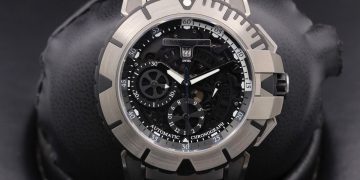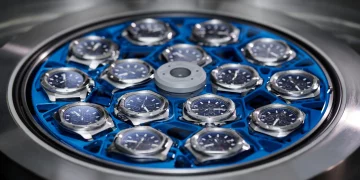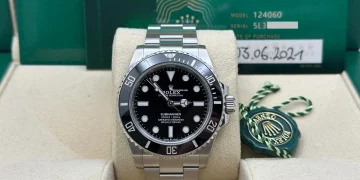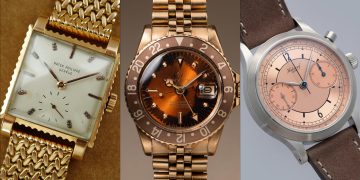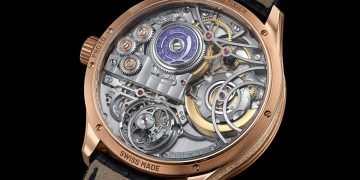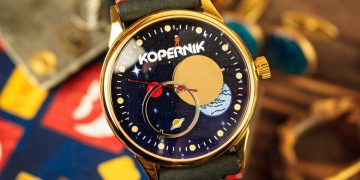When choosing a luxury watch, the decision goes beyond just design or aesthetics—it involves understanding how movement and dial materials influence your comfort and the long-term durability of the timepiece. While the movement is the beating heart of the watch, determining how well it keeps time and functions, the dial material impacts not only its appearance but also how it performs in various environments. Both components play crucial roles in your overall experience with the watch.
This article will examine how different watch movements and dial materials affect daily wear, comfort, and the longevity of your luxury timepiece.
1. Watch Movements: The Heartbeat of Comfort and Durability
The movement of a watch is often considered its most crucial element. It dictates the accuracy, smoothness, and reliability of the timepiece, all of which contribute to your experience when wearing it daily. There are two main types of watch movements: automatic and quartz. While mechanical movements (which include automatic and manual winding mechanisms) offer a high degree of craftsmanship, quartz movements are more practical and often more durable for everyday use.
Automatic Movements: Comfort and Craftsmanship
Automatic movements are highly revered for their craftsmanship. These movements work through a self-winding mechanism, powered by the motion of the wearer’s wrist.
- Comfort:
- Since automatic watches require no battery, they tend to feel lighter and more ergonomically balanced when worn for extended periods. The oscillating rotor inside the movement generates energy, creating a sense of continuous action and fluidity. This can be pleasant for users who prefer a natural feel when wearing their watch. However, they might be slightly heavier than quartz alternatives due to the mechanical parts inside.
- They also tend to have smoother ticking movements, offering a sense of luxury that quartz watches lack. This may appeal to those who enjoy the subtle sensations of their watch’s movement.
- Durability:
- Quality automatic movements from brands like Rolex, Patek Philippe, and Audemars Piguet can be incredibly durable, but they require regular maintenance. Automatic watches are more susceptible to damage if exposed to extreme conditions, such as strong shocks or magnetic fields.
- Water resistance can vary, but automatic movements often require extra care in extreme environments. The mechanical parts inside are more complex and sensitive than those found in quartz watches.
Quartz Movements: Precision and Practicality
Quartz movements are powered by a battery, which makes them more accurate and low-maintenance compared to mechanical watches.
- Comfort:
- Lightweight: Quartz watches are generally lighter because they lack the intricate, heavy components of automatic movements. This makes them ideal for daily wear, especially for those who prefer a featherlight feel on the wrist.
- Accuracy: Quartz movements provide near-perfect timekeeping, so you won’t have to worry about the small fluctuations that sometimes affect automatic watches. This makes them incredibly practical, especially for those who rely on punctuality.
- Durability:
- Quartz movements have fewer moving parts, which translates to a lower likelihood of mechanical failure. Because of this, they’re often more resilient and less prone to damage than automatic movements.
- Battery life is one factor to consider, as you will need to replace the battery every 1-3 years. However, quartz watches often require less maintenance overall, which makes them perfect for hassle-free daily wear.

2. Dial Materials: Appearance, Comfort, and Durability
The material used in the dial of a watch greatly influences its aesthetic appeal, but it also affects how well the watch holds up over time, especially during everyday wear. Watch dials come in a variety of materials, each with unique properties that contribute to both comfort and longevity. Common dial materials include metal, ceramic, sapphire crystal, and enamel.
Metal Dials: Classic Elegance and Durability
Metal dials are classic, with materials such as stainless steel, brass, or gold being popular choices.
- Comfort:
- Smooth Surface: Metal dials can be quite smooth, offering a polished finish that feels pleasant against the skin. Their shine is also subtle and understated, ensuring that the watch maintains a refined look.
- However, reflectivity can sometimes be an issue, especially under bright lighting conditions. Watches with metal dials can sometimes be a bit glare-prone, though higher-end models may include anti-reflective coatings.
- Durability:
- Scratch Resistance: While metal dials can be fairly resistant to scratches, they may dull over time if subjected to heavy wear. Brushed metal dials are less prone to showing scratches compared to highly polished metal.
- Longevity: Watches with metal dials are often durable and can handle exposure to daily wear and tear better than softer dial materials.
Ceramic Dials: Modern Look and Extreme Durability
Ceramic is an advanced material used in high-end luxury watches and is often used for both the case and the dial.
- Comfort:
- Lightweight: Ceramic dials are generally lighter than metal counterparts, making them comfortable for prolonged wear. They also feel smooth and have a sleek, modern aesthetic.
- Scratch Resistance: One of the major benefits of ceramic is its extreme scratch resistance, which ensures that the dial maintains its flawless look over time.
- Durability:
- Highly Resilient: Ceramic is very hard and does not oxidize or fade with exposure to UV light, making it ideal for maintaining its aesthetic over years.
- While ceramic is tough, it is also brittle, so there’s a chance of it shattering if subjected to a hard impact.
Sapphire Crystal Dials: Ultimate Scratch Resistance
Sapphire crystal is a popular material for watch glass or crystals, but it can also be used in the dial of some luxury timepieces. Known for its exceptional durability and optical clarity, sapphire is considered one of the most robust materials available.
- Comfort:
- Clear and Light: Sapphire dials are usually paired with clear, transparent covers that allow for excellent legibility. The material’s clarity also prevents any distortion when reading the time.
- The smooth finish and sleek feel of sapphire can provide a comfortable experience for daily wear.
- Durability:
- Scratch Resistance: Sapphire crystal is extremely resistant to scratches, ensuring that your watch maintains a clear, flawless dial for a long time.
- Toughness: However, sapphire can be susceptible to cracking or shattering under heavy impact. While it’s very resistant to scratches, it’s important to treat the watch with care during daily activities that could subject it to hard knocks.
Enamel Dials: Old-World Charm and Timeless Durability
Enamel is a traditional material used for crafting high-end dials, known for its depth and luster.
- Comfort:
- Smooth and Polished: Enamel dials feel smooth to the touch and provide a luxurious tactile experience. The glossy finish makes for a polished look but can sometimes be prone to reflections.
- Durability:
- Highly Resilient: Enamel is resistant to fading and discoloration, offering a high degree of longevity. It’s often used in watches with heritage or classical appeal.
- Fragility: While enamel is resistant to fading, it’s also fragile. A strong impact can result in chipping or cracking, so care must be taken to prevent accidental drops.
Conclusion: Balancing Comfort and Durability in Your Luxury Watch
The movement and dial material of a watch significantly influence both its comfort and durability during everyday wear. If you prefer a lighter, more accurate, and low-maintenance watch, a quartz movement with a ceramic or metal dial could be the right fit for you. However, if you appreciate the craftsmanship of mechanical movements and are willing to take extra care in handling the watch, an automatic movement with a sapphire or enamel dial might offer the perfect balance of luxury, comfort, and timeless durability.
Ultimately, understanding the characteristics of these key components helps ensure that the watch you choose not only meets your style preferences but also suits your lifestyle, ensuring that it remains a trusted and comfortable companion for years to come.



